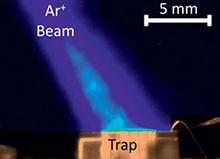Summary
The Ion Traps Project collaborates with PML's Ion Storage Group to lower the intrinsic heating of ions from ion trap components.
Description

Trapped ions are sensitive to electric-field noise from trap-electrode surfaces. This noise has been an obstacle to progress in trapped-ion quantum information processing (QIP) experiments for more than a decade. It causes motional heating of the ions, and thus quantum-state decoherence. This heating is anomalous because it is not easily explained by typical technical-noise sources. Experimental evidence of its dependence on ion-electrode distance, frequency, and electrode temperature points to the surface, rather than the bulk, of the trap electrodes as the origin. Our experimental efforts and models to help identify and reduce or eliminate the source of the anomalous heating. Recent progress to reduce the heating with in-situ cleaning indicates that it may not be a fundamental limit to trapped-ion QIP. Moreover, the extreme sensitivity of trapped ions to electric-field noise may potentially be used as a new tool in surface science.
Major Accomplishments
Reduction of ion trap heating rates by two orders of magnitude – Quantum Information processing based on trapped ions is one of the most promising approaches to this emerging technology. Keeping an ion in its ground state long enough to run computations is essential to making this technology viable. Anomalous heating of the ions due to fluctuating electric fields is one of the main obstacles to achieving this. In collaboration with the Wineland ion trap group, we are working to understand and reduce this anomalous heating. By carefully cleaning the electrodes of the ion traps in-situ, we have been able to demonstrate two orders of magnitude reduction of the ion heating rate, thereby allowing ion trap researchers to reduce the ion-surface distance and speed up quantum gates. The image shows the ion mill cleaning of an ion trap from the side. We currently have devised a stylus ion trap that suspends an ion relatively high above the surface, allowing us to bring other surfaces into close proximity with the ion to test cleaning procedures and evaluate their efficacy for future development into ion trap electrodes and preparation. (photo courtesy of D. Hite & Y. Coulomb).
Surface science for improved ion traps, D. A. Hite , Y. Colombe, A. C. Wilson, D. T. C. Allcock, D. Leibfried, D. J. Wineland, and D. P. Pappas, MRS Bulletin 38 , 826 (2013)

